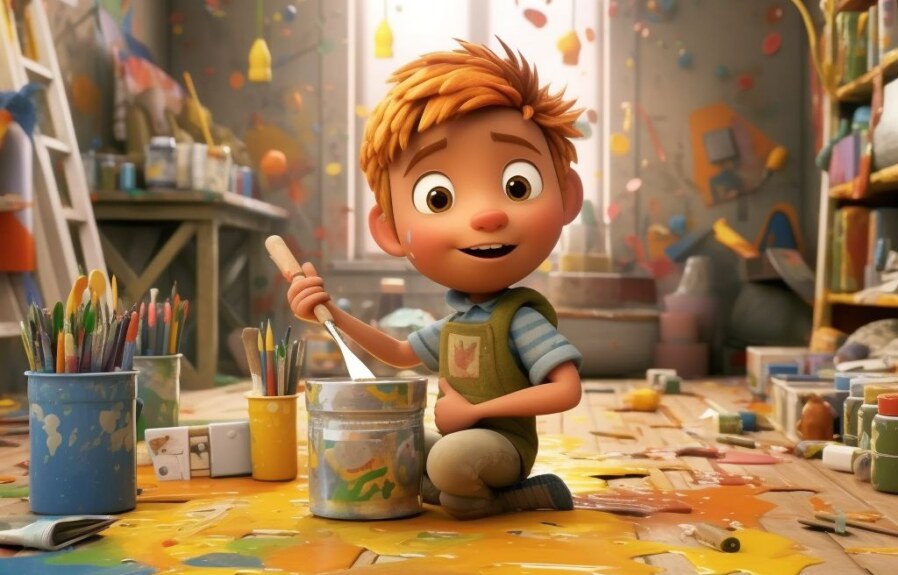Creating gold paint is the ultimate solution for enhancing your art pieces while giving them a luxurious feel. The mesmerizing shine and spark of gold paint make it an ideal choice for a wide range of artistic endeavors, from painting to crafts. However, purchasing gold paint can be relatively expensive and might not suit everyone’s budget. The good news is that you can easily make your golden paint at home with a few basic ingredients and tools. In this article, we will walk you through the step-by-step process of creating Gold Paint like a pro. So, let’s delve into the fascinating world of DIY gold paint-making and unleash your creativity to the fullest.
1. Introduction: Understanding the Basics of Gold Paint
How to Make Gold Paint: An Ultimate Guide
Understanding the Basics of Gold Paint
Before delving into the details of making gold paint, it is essential to comprehend the fundamentals of this beautiful pigment. Gold paint comes in various shades, ranging from pale and bright to darker hues. The type of gold paint you use will primarily depend on the effect you want to achieve in your artwork.
Gold paint is made using actual gold or using a combination of other pigments and mediums that give the paint a metallic finish, making the hue shimmer and shine. The overall goal is to mimic the properties of natural gold, with the added benefit of easier application and longevity.
Artists have been using gold paint in their creations for centuries, and it has become a symbol of luxury and wealth over time. Some of the most renowned artists in history have incorporated gold into their artwork, including Gustav Klimt, who created stunning and intricately detailed pieces using gold leaf.
In the following sections, we will explore how to make gold paint from scratch and the best pigments and mediums to achieve the perfect color and consistency. We will also discuss alternative techniques for incorporating gold into your artwork. Stay tuned!
2. Making Gold Paint from Scratch: A Step-by-Step Guide
In this section, we will walk you through the process of making your very own gold paint from scratch. You can use this paint to add a little glitter and glamour to your artwork or DIY project.
Step 1: Gather Your Materials
First, you will need to gather your materials. To make your own gold paint, you will need:
- Gold pigment powder
- Binder medium (such as linseed oil or acrylic medium)
- Small container or mixing tray
- Measuring spoons
- Paintbrush
Step 2: Mix Your Pigment
Next, you will need to mix your pigment powder with your binder medium. The ratio will depend on the specific pigment and medium you are using, so be sure to read the instructions carefully. In general, you will want to add a small amount of pigment powder to a larger amount of binder medium.
Tip: Too much pigment powder can result in a grainy or lumpy texture. Start with a small amount and gradually add more as needed.
Step 3: Test and Adjust
Once you have mixed your pigment and medium together, it’s time to test the consistency and color. Use your paintbrush to apply a small amount of paint to a piece of paper or canvas.
Tip: Use a white background to best see the color of your gold paint.
If the color is not quite right or the consistency is too thick or thin, you can adjust by adding more pigment or medium, respectively.
Once you have achieved the perfect gold paint, you can use it to add a touch of luxury to any project.
3. Selecting the Right Pigments and Mediums for Your Gold Paint
One of the most important parts of making gold paint is selecting the right pigments and mediums to achieve the desired color and consistency. Here are some tips to help you choose:
- Choose the Right Pigments: Gold paint can come from a variety of pigments, but authentic gold paint is made from real gold flakes. While this can be expensive, metallic pigments or mica powders can be used for a similar effect. Look for pigments that have a high concentration of gold, brass, or copper.
- Select the Mediums: When making gold paint, the type of medium you use can greatly affect the final product. To create a metallic sheen, consider using a medium like gum arabic, which is a sticky plant resin that acts as a binding agent. Glycerin is another option to add to your paint for a thicker consistency.
- Test and Experiment: To find the perfect balance of pigments and mediums, always test your mixture to achieve your desired result. The right medium can help you achieve the right consistency and shine of metallic paints.
When combining pigments and mediums, it is essential to strike a balance between them. Experimenting with different combinations can lead to a unique, custom-made gold paint that is perfect for your artistic needs. The possibilities are endless, so enjoy the process of experimenting and creating the perfect gold paint.
4. Tips and Tricks for Achieving the Perfect Consistency and Color
When working with gold paint, achieving the perfect consistency and color can be challenging. You may find yourself struggling to attain the right balance in your mixture. Fortunately, there are a few tips and tricks that can help you achieve the perfect gold paint.
Tip 1: Experiment with Different Pigments
One of the most important factors that contribute to the color and consistency of your gold paint is the type of pigment you use. Experimenting with different pigments can give you a better understanding of which ones work best for your desired color and consistency.
- For a brighter and more luminous gold, try using a combination of cadmium pigment with titanium white.
- If you are looking for a warmer and deeper gold tone, try mixing yellow ochre and burnt sienna pigments.
- For a metallic gold effect, try using metallic gold pigments or mica powders.
Tip 2: Mix in Small Amounts
When mixing your gold paint, it’s important to mix in small amounts at a time. This helps you have more control over the consistency and color of your paint. Mixing large amounts can lead to unevenness and inconsistency in your mixture.
Start with small amounts of pigment and medium, and gradually mix in more as needed until you achieve your desired consistency and color.
Tip 3: Use the Right Mediums
The medium you use in your gold paint can greatly affect the consistency and color of your mixture. Using the right medium can make all the difference in achieving your desired end result.
Common mediums for gold paint include:
- Acrylic binder: This is good for achieving a bold and vibrant gold color.
- Gum arabic: This is good if you’re going for a metallic gold effect.
- Liquid polymer medium: This is good if you want your gold paint to have more texture and depth.
By following these tips and experimenting with different pigments and mediums, you’ll be able to achieve the perfect consistency and color in your gold paint.
5. Applying Gold Paint to Achieve a Beautiful and Lasting Finish
Once you’ve made your own gold paint and achieved the desired consistency and color, the next step is applying it to your artwork to achieve that beautiful and lasting finish you desire. Here are some tips to make sure your gold paint application is successful:
Preparation
Before you start applying your gold paint, make sure your artwork is clean and dry. Remove any dust or debris with a soft brush or cloth, and let it dry completely. Apply a primer if necessary to ensure the surface is smooth and even. It’s also a good idea to practice with the gold paint on a separate piece of paper or canvas before applying it to your artwork to get a feel for how it flows and the amount of pressure needed.
Application Techniques
The application technique you use will depend on the type of artwork you are creating and the effect you want to achieve. You can apply gold paint with a brush, sponge, or even your fingers. Some popular techniques include stippling, blending, dry brushing, and layering. Make sure to apply the gold paint in thin layers, as thick layers can crack or peel over time.
Finishing Touches
Once you’ve applied your gold paint, let it dry completely before adding any additional layers or finishing touches. You can seal your artwork with a varnish or clear coat to protect the gold paint and create a glossy finish. Another option is to use gold leaf or gold flakes to add texture and dimension to your artwork.
By following these tips and experimenting with different application techniques, you can achieve a beautiful and lasting finish with your homemade gold paint. Don’t be afraid to get creative and try new things to make your artwork stand out.
6. Alternative Techniques for Adding Gold to Your Artwork
If making your own gold paint from scratch seems daunting or you’re looking for alternative ways to incorporate gold into your artwork, there are a variety of techniques to explore.
1. Gold Leaf
Gold leaf is a traditional decorative material made by hammering pure gold into thin sheets. It has been used for centuries in art and architecture, and can add a luxurious and shimmering effect to your artwork. To apply gold leaf, you will need to use an adhesive, such as gold size or adhesive gilding paste. Apply the adhesive to your surface, wait for it to dry to a tacky consistency, and then carefully lay the gold leaf on top, patting it down until it adheres. Once the gold leaf is in place, use a soft brush to remove any excess sheets.
2. Gold Paint Pens
Gold paint pens are an easy and convenient way to add gold details and accents to your artwork. They come in a variety of tip sizes and can be used on a range of surfaces, from paper to canvas. The pens contain a metallic paint that dries quickly and can be layered for a more prominent effect. For best results, shake the pen before use and test it on a separate surface before applying it to your artwork.
3. Gold Powder
Gold powder can be mixed with various mediums, such as acrylic or oil paint, to create a more subtle and subdued gold effect. The powder can also be used to make a glittery gold texture by mixing it with gel medium and applying it with a palette knife. When using gold powder, be sure to wear gloves and work in a well-ventilated area to avoid inhaling the fine particles.
Whether you’re using gold leaf, paint pens, or powder, incorporating gold into your artwork can add a touch of elegance and sophistication. Experiment with different techniques and mediums to find the perfect gold accent for your next masterpiece.
7. Conclusion: Experimenting and Creating Your Perfect Gold Paint
If you want to create gold paint that suits your preference, you need to experiment with pigments, mediums, and techniques.
Creating gold paint involves the right combination of pigment, medium, and techniques. It is essential to note that this process requires patience, as achieving the perfect color and consistency may take time. You may need to create some batches before settling on the ideal formulation. One of the best things about creating your gold paint is that you can experiment and tweak it until it suits your needs the best.
There are many ways to create gold artwork using other techniques rather than gold paint.
Apart from creating gold paint, you can create a gold effect using various techniques. Some of these techniques include using gold leaf, gold powder, gold ink, and metallic paints. For instance, using gold leaf involves applying a thin sheet of gold to paper or canvas using an adhesive. Alternatively, you can use gold powder or metallic paint to achieve a similar effect. It is essential to note that different techniques will produce different effects, depending on the paint’s color, surface, and texture.
Final Thoughts
Creating gold paint provides artists with the opportunity to create a unique and custom-made color for their art. Experimenting with pigments, mediums, and techniques can help you create gold paint that suits your preference. If you’re having trouble creating the perfect shade or consistency, don’t shy away from experimenting with different formulations until you’re satisfied. Remember, it’s not just about creating beautiful art but also enjoying the process of creating it. Have fun with it!
People Also Ask
1. How do you make gold paint with acrylics?
To make gold paint with acrylics, start with a metallic gold base, add a small amount of black, and mix in some yellow and red to tone it down. Then, add a touch of white to give it a brighter sparkle.
2. Can you make gold paint at home?
Yes, you can make gold paint at home using simple ingredients like turmeric, cornstarch, and yellow food coloring. Simply mix these ingredients with water until you reach your desired consistency and color.
3. What is the best gold paint to use?
The best gold paint to use depends on your project and personal preferences, but some top options include metallic gold acrylic paint, liquid gold leaf, and gold spray paint.
4. What colors make gold shine?
To make gold shine, mix together red, yellow, and white paint to create a bright, shimmery gold hue. For a deeper shade of gold, add a bit of black paint as well.
5. Can you mix gold paint with other colors?
Yes, you can mix gold paint with other colors to create unique hues and shades. Some popular combinations include gold and black for a more subdued look or gold and red for a bold, fiery tone.
Conclusion
Making gold paint is a fun and rewarding DIY project that allows you to create unique shades and hues for your artwork or decorations. Experiment with different ingredients and color combinations to find the perfect shade of gold for your project.



